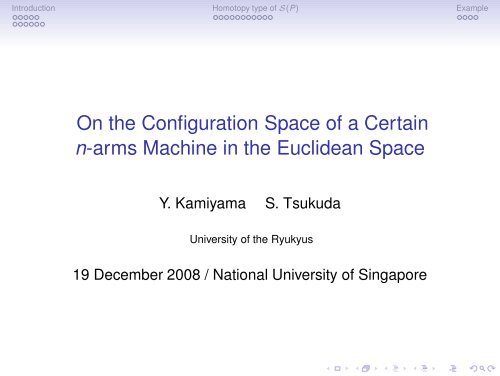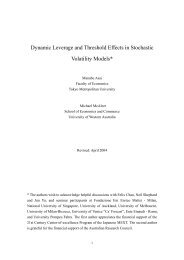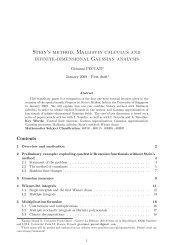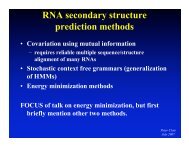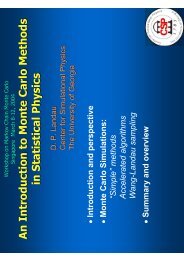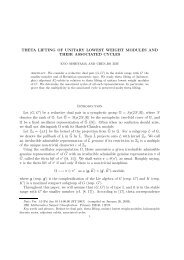Configuration spaces
Configuration spaces
Configuration spaces
You also want an ePaper? Increase the reach of your titles
YUMPU automatically turns print PDFs into web optimized ePapers that Google loves.
Introduction Homotopy type of S(P) Example<br />
On the <strong>Configuration</strong> Space of a Certain<br />
n-arms Machine in the Euclidean Space<br />
Y. Kamiyama S. Tsukuda<br />
University of the Ryukyus<br />
19 December 2008 / National University of Singapore
Introduction Homotopy type of S(P) Example<br />
Introduction<br />
An n-arms Machine and the <strong>Configuration</strong> Space M(P, a)<br />
Results<br />
Homotopy type of S(P)<br />
Short Arms Case<br />
Example<br />
Octahedron
Introduction Homotopy type of S(P) Example<br />
Introduction<br />
An n-arms Machine and the <strong>Configuration</strong> Space M(P, a)<br />
Results<br />
Homotopy type of S(P)<br />
Short Arms Case<br />
Example<br />
Octahedron
Introduction Homotopy type of S(P) Example<br />
Introduction<br />
An n-arms Machine and the <strong>Configuration</strong> Space M(P, a)<br />
Results<br />
Homotopy type of S(P)<br />
Short Arms Case<br />
Example<br />
Octahedron
Introduction Homotopy type of S(P) Example<br />
Introduction<br />
An n-arms Machine and the <strong>Configuration</strong> Space M(P, a)<br />
Results<br />
Homotopy type of S(P)<br />
Short Arms Case<br />
Example<br />
Octahedron
Introduction Homotopy type of S(P) Example<br />
An n-arms Machine<br />
How much freedom does a trapped bug have?<br />
× <br />
× <br />
• •<br />
<br />
<br />
∩ • <br />
×<br />
• ○ <br />
×<br />
•<br />
<br />
• <br />
<br />
× ×
Introduction Homotopy type of S(P) Example<br />
An n-arms Machine<br />
How much freedom does a trapped bug have?<br />
× × <br />
• •<br />
<br />
<br />
∩ × ○ ×<br />
•<br />
<br />
<br />
• <br />
•<br />
<br />
<br />
• × ×
Introduction Homotopy type of S(P) Example<br />
An n-arms Machine<br />
a > 0, v 1 , . . . , v n ∈ R d .<br />
v 3<br />
v 2<br />
v 4<br />
v 5 v 6<br />
v 1
Introduction Homotopy type of S(P) Example<br />
<br />
An n-arms Machine<br />
a > 0, v 1 , . . . , v n ∈ R d .<br />
We consider an n-arms machine,<br />
which have n two-joined arms of length a,<br />
v 3<br />
v 2<br />
<br />
•<br />
<br />
• <br />
<br />
• <br />
<br />
v 4 • v 1<br />
•<br />
<br />
<br />
<br />
• <br />
•<br />
<br />
<br />
<br />
v 5 v 6
Introduction Homotopy type of S(P) Example<br />
An n-arms Machine<br />
a > 0, v 1 , . . . , v n ∈ R d .<br />
We consider an n-arms machine,<br />
which have n two-joined arms of length a,<br />
with the end of the i-th arm fixed at v i .<br />
v 3<br />
v 2<br />
<br />
•<br />
<br />
• <br />
• <br />
v • <br />
4 • <br />
v 1<br />
•<br />
<br />
• <br />
<br />
v 5 v 6
Introduction Homotopy type of S(P) Example<br />
The <strong>Configuration</strong> Space M(P, a)<br />
Denote the configuration space of the n-arms machine by<br />
M(v 1 , . . . , v n , a).
Introduction Homotopy type of S(P) Example<br />
The <strong>Configuration</strong> Space M(P, a)<br />
Definition<br />
M(v 1 , . . . , v n , a) ⊂ ( R d) n+1
Introduction Homotopy type of S(P) Example<br />
The <strong>Configuration</strong> Space M(P, a)<br />
Definition<br />
M(v 1 , . . . , v n , a) ⊂ ( R d) n+1<br />
:= { (p 1 , . . . , p n , q) ‖p i − v i ‖ = ‖q − p i ‖ = a 2 , ∀i}
Introduction Homotopy type of S(P) Example<br />
The <strong>Configuration</strong> Space M(P, a)<br />
Definition<br />
M(v 1 , . . . , v n , a) ⊂ ( R d) n+1<br />
:= { (p 1 , . . . , p n , q) ‖p i − v i ‖ = ‖q − p i ‖ = a 2 , ∀i}<br />
v 3<br />
v 2<br />
<br />
p<br />
p 2 3 <br />
p<br />
v p 4 <br />
<br />
4 q 1 <br />
v 1<br />
<br />
<br />
p 5 p 6<br />
<br />
<br />
<br />
v 5 v 6
Introduction Homotopy type of S(P) Example<br />
The <strong>Configuration</strong> Space M(P, a)<br />
Definition<br />
When {v 1 , . . . , v n } is the set of vertices of a polyhedron P ⊂ R d ,<br />
we denote M(v 1 , . . . , v n , a) by M(P, a).<br />
v 3<br />
v 2<br />
<br />
p<br />
p 2 3 <br />
p<br />
v p 4 <br />
<br />
4 q 1 <br />
v 1<br />
<br />
<br />
p 5 p 6<br />
<br />
<br />
<br />
v 5 v 6
Introduction Homotopy type of S(P) Example<br />
Known Results (d = 2)<br />
When d = 2, namely, in R 2 ,<br />
M(v 1 , . . . , v n , a) is an orientable closed surface in many cases.<br />
• D. Eldar, Maps and Machines, Hebrew Univ. MSc project<br />
http://www.math.toronto.edu/~drorbn/People/Eldar/thesis<br />
• [1] D. Blanc, M. Shoham, N. Shvalb<br />
• [3] N. Shvalb, G. Liu, M. Shoham, J. C. Trinkle
Introduction Homotopy type of S(P) Example<br />
Known Results (d = 2)<br />
When d = 2, namely, in R 2 ,<br />
M(v 1 , . . . , v n , a) is an orientable closed surface in many cases.<br />
• D. Eldar, Maps and Machines, Hebrew Univ. MSc project<br />
http://www.math.toronto.edu/~drorbn/People/Eldar/thesis<br />
• [1] D. Blanc, M. Shoham, N. Shvalb<br />
• [3] N. Shvalb, G. Liu, M. Shoham, J. C. Trinkle
Introduction Homotopy type of S(P) Example<br />
Known Results (d ≥ 3)<br />
When d ≥ 3, namely, in R d ,<br />
we determined the homotopy type of M(P, a) in the case when<br />
P ⊂ R 2 ⊂ R d is a regular n-gon and the arms are short ([2]<br />
Y. Kamiyama, T).
Introduction Homotopy type of S(P) Example<br />
Introduction<br />
An n-arms Machine and the <strong>Configuration</strong> Space M(P, a)<br />
Results<br />
Homotopy type of S(P)<br />
Short Arms Case<br />
Example<br />
Octahedron
Introduction Homotopy type of S(P) Example<br />
In This Talk<br />
We consider the case when d = 3 and<br />
v 3<br />
v 2<br />
<br />
p<br />
p 2 3 <br />
p<br />
v p 4 <br />
<br />
4 q 1 <br />
v 1<br />
<br />
<br />
p 5 p 6<br />
<br />
<br />
<br />
v 5 v 6
Introduction Homotopy type of S(P) Example<br />
In This Talk<br />
We consider the case when d = 3 and<br />
P is a regular polyhedron P ⊂ R 3 or<br />
a regular n-gon P ⊂ R 2 × {0} ⊂ R 3 .<br />
v 3<br />
v 2<br />
v 4<br />
v 5 v 6<br />
v 1
Introduction Homotopy type of S(P) Example<br />
In This Talk<br />
We consider the case when d = 3 and<br />
P is a regular polyhedron P ⊂ R 3 or<br />
a regular n-gon P ⊂ R 2 × {0} ⊂ R 3 .<br />
We assume that the center of P is located at the origin of R d .<br />
v 3<br />
v 2<br />
v 4<br />
v 5 v 6<br />
o v 1
Introduction Homotopy type of S(P) Example<br />
In This Talk<br />
Let l(P) and L(P) be the radius and the diameter of P, respectively.<br />
Definition<br />
l(P) := ‖v 1 ‖ (= ‖v i ‖, ∀i)<br />
L(P) := max 1≤i≤n ‖v i − v 1 ‖<br />
v 3<br />
L(P)<br />
v 2<br />
v o v 1<br />
4<br />
l(P)<br />
v 5 v 6
Introduction Homotopy type of S(P) Example<br />
Easy Facts<br />
• M(P, a) = ∅ if a < l(P)<br />
• M(P, a) = {∗} if a = l(P)<br />
v 1<br />
•<br />
v 2 v 3
Introduction Homotopy type of S(P) Example<br />
Easy Facts<br />
• M(P, a) = ∅ if a < l(P)<br />
• M(P, a) = {∗} if a = l(P)<br />
v 1<br />
•<br />
v 2 v 3
Introduction Homotopy type of S(P) Example<br />
Short and Long Arms (Changing a for a Fixed P)<br />
Proposition<br />
1. The topological type of M(P, a) is constant for<br />
l(P) < a < L(P).<br />
2. The topological type of M(P, a) is constant for a > L(P).<br />
We denote M(P, a) by S(P) if l(P) < a < L(P) and by L(P) if<br />
a > L(P).<br />
v 1<br />
•<br />
v 2 v 3
Introduction Homotopy type of S(P) Example<br />
Short and Long Arms (Changing a for a Fixed P)<br />
Proposition<br />
1. The topological type of M(P, a) is constant for<br />
l(P) < a < L(P).<br />
2. The topological type of M(P, a) is constant for a > L(P).<br />
We denote M(P, a) by S(P) if l(P) < a < L(P) and by L(P) if<br />
a > L(P).<br />
v 1<br />
•<br />
v 2 v 3
Introduction Homotopy type of S(P) Example<br />
Homology<br />
Theorem<br />
The integral homology groups H ∗ (S(P)), H ∗ (L(P)) are torsion<br />
free and the Poincaré polynomials are given by<br />
1. Regular n-gon<br />
PS(S(P)) =1 +<br />
n∑<br />
i=4<br />
{<br />
n<br />
( n − 2<br />
i − 3<br />
)<br />
−<br />
( )} n<br />
t i + t n+3<br />
i − 2<br />
PS(L(P)) =1 + t 2 + nt 3 (1 + t) n−2<br />
∑n+1<br />
( ) n<br />
+ (2n + 3 − 2i) t i + t n+3<br />
i − 2<br />
i=2
Introduction Homotopy type of S(P) Example<br />
Homology<br />
Theorem<br />
The integral homology groups H ∗ (S(P)), H ∗ (L(P)) are torsion<br />
free and the Poincaré polynomials are given by<br />
2. Tetrahedron<br />
PS(S(P)) =1 + t 7<br />
PS(L(P)) =1 + 8t 2 + 24t 3 + 24t 4 + 8t 5 + t 7
Introduction Homotopy type of S(P) Example<br />
Homology<br />
Theorem<br />
The integral homology groups H ∗ (S(P)), H ∗ (L(P)) are torsion<br />
free and the Poincaré polynomials are given by<br />
3. Octahedron<br />
PS(S(P)) =1 + 3t 3 + 3t 6 + t 9<br />
PS(L(P)) =1 + 12t 2 + 63t 3 + 120t 4<br />
+ 120t 5 + 63t 6 + 12t 7 + t 9
Introduction Homotopy type of S(P) Example<br />
Homology<br />
Theorem<br />
The integral homology groups H ∗ (S(P)), H ∗ (L(P)) are torsion<br />
free and the Poincaré polynomials are given by<br />
4. Cube<br />
PS(S(P)) =1 + 4t 3 + 8t 5 + 36t 6 + 40t 7 + 16t 8 + t 11<br />
PS(L(P)) =1 + 16t 2 + 116t 3 + 336t 4 + 568t 5<br />
+ 596t 6 + 376t 7 + 128t 8 + 16t 9 + t 11
Introduction Homotopy type of S(P) Example<br />
Homology<br />
Theorem<br />
The integral homology groups H ∗ (S(P)), H ∗ (L(P)) are torsion<br />
free and the Poincaré polynomials are given by<br />
5. Icosahedron and Dodecahedron: omitted
Introduction Homotopy type of S(P) Example<br />
Manifold<br />
Remark<br />
If P is a regular n-gon (n = 2, 3) or a simplicial regular<br />
polyhedron, namely, a tetrahedron, an octahedron or an<br />
icosahedron, then M(P, a) is a smooth closed orientable<br />
manifold. ( D. Blanc, M. Shoham, N. Shvalb [1, Theorem 2.1] )
Introduction Homotopy type of S(P) Example<br />
Introduction<br />
An n-arms Machine and the <strong>Configuration</strong> Space M(P, a)<br />
Results<br />
Homotopy type of S(P)<br />
Short Arms Case<br />
Example<br />
Octahedron
Introduction Homotopy type of S(P) Example<br />
Homotopy Type of S(P)<br />
Theorem<br />
1. Let P(n) ⊂ R 2 ⊂ R 3 be a regular n-gon. Then there exists<br />
a homotopy equivalence<br />
⎛ ⎞<br />
n−2<br />
∨<br />
S(P(n)) ≃ ⎝ ∨<br />
S i+2 ⎠ ∨ S n+3<br />
i=2<br />
where α(n, i) := n ( n−2<br />
i−1)<br />
−<br />
( n<br />
i<br />
)<br />
.<br />
α(n,i)
Introduction Homotopy type of S(P) Example<br />
Homotopy Type of S(P)<br />
Theorem<br />
2. If P ⊂ R 3 is a regular convex polyhedron, then<br />
⎛<br />
⎞<br />
ΣS(P) ≃ Σ ⎝ ∨<br />
S |I| ∧ S(I ∆ ) ⎠<br />
∅≠I⊂V<br />
where V : the set of verticex of P,<br />
I ∆ : the union of the faces of P ∆ those correspond to<br />
vertices in I
Introduction Homotopy type of S(P) Example<br />
Workspace<br />
Definition<br />
Let D i := { x ∈ R 3 ‖x − v i ‖ ≤ a } ⊂ R 3 be the disc centered at<br />
v i .<br />
The space B = ⋂ n<br />
i=1 D i is called the workspace.<br />
We set F i = B ∩ ∂D i . ∂B is devided into spherical regions<br />
F 1 , . . . , F n , and by this decomposition,<br />
B ∼ = P ∆ if P is a regular polyhedron (P ∆ : the dual of P),<br />
B ∼ = S(P ∆ ∩ R 2 ) if P is a regular n-gon.<br />
F 3<br />
v 1<br />
F 2<br />
v 2<br />
B<br />
v 3
Introduction Homotopy type of S(P) Example<br />
Workspace<br />
Definition<br />
Let D i := { x ∈ R 3 ‖x − v i ‖ ≤ a } ⊂ R 3 be the disc centered at<br />
v i .<br />
The space B = ⋂ n<br />
i=1 D i is called the workspace.<br />
We set F i = B ∩ ∂D i . ∂B is devided into spherical regions<br />
F 1 , . . . , F n , and by this decomposition,<br />
B ∼ = P ∆ if P is a regular polyhedron (P ∆ : the dual of P),<br />
B ∼ = S(P ∆ ∩ R 2 ) if P is a regular n-gon.<br />
F 3<br />
v 1<br />
F 2<br />
v 2<br />
B<br />
v 3
Introduction Homotopy type of S(P) Example<br />
Workspace<br />
Definition<br />
Let D i := { x ∈ R 3 ‖x − v i ‖ ≤ a } ⊂ R 3 be the disc centered at<br />
v i .<br />
The space B = ⋂ n<br />
i=1 D i is called the workspace.<br />
We set F i = B ∩ ∂D i . ∂B is devided into spherical regions<br />
F 1 , . . . , F n , and by this decomposition,<br />
B ∼ = P ∆ if P is a regular polyhedron (P ∆ : the dual of P),<br />
B ∼ = S(P ∆ ∩ R 2 ) if P is a regular n-gon.<br />
F 3<br />
v 1<br />
F 2<br />
v 2<br />
B<br />
v 3
Introduction Homotopy type of S(P) Example<br />
Workspace<br />
Definition<br />
Let D i := { x ∈ R 3 ‖x − v i ‖ ≤ a } ⊂ R 3 be the disc centered at<br />
v i .<br />
The space B = ⋂ n<br />
i=1 D i is called the workspace.<br />
We set F i = B ∩ ∂D i . ∂B is devided into spherical regions<br />
F 1 , . . . , F n , and by this decomposition,<br />
B ∼ = P ∆ if P is a regular polyhedron (P ∆ : the dual of P),<br />
B ∼ = S(P ∆ ∩ R 2 ) if P is a regular n-gon.<br />
F 3<br />
v 1<br />
F 2<br />
v 2<br />
B<br />
v 3
Introduction Homotopy type of S(P) Example<br />
S(P) as a Quotient Space<br />
It is not hard to see that<br />
S(P) ∼ =<br />
(S 1) n /<br />
× B<br />
∼<br />
(1)<br />
where the equivalence relation ∼ is generated by the following<br />
relations:<br />
(x 1 , . . . , x n , q) ∼ (x 1 , . . . , i ∗, . . . , x n , q) if q ∈ F i .
Introduction Homotopy type of S(P) Example<br />
S(P) as a Homotopy Colimit (Source and Target<br />
Categories)<br />
We consider the case when P is a regular convex polyhedron.<br />
• V = {v 1 , . . . , v n } : the set of vertices of P<br />
• P : the face poset of ∂P,namely,<br />
P ⊂ P(V ) : subposet<br />
I ∈ P ⇔ I spans a face of ∂P<br />
¯P = P ∪ {∅} ⊂ P(V ).<br />
• T ∗ : the category of pointed compactly generated<br />
topological <strong>spaces</strong>
Introduction Homotopy type of S(P) Example<br />
S(P) as a Homotopy Colimit (Source and Target<br />
Categories)<br />
We consider the case when P is a regular convex polyhedron.<br />
• V = {v 1 , . . . , v n } : the set of vertices of P<br />
• P : the face poset of ∂P,namely,<br />
P ⊂ P(V ) : subposet<br />
I ∈ P ⇔ I spans a face of ∂P<br />
¯P = P ∪ {∅} ⊂ P(V ).<br />
• T ∗ : the category of pointed compactly generated<br />
topological <strong>spaces</strong>
Introduction Homotopy type of S(P) Example<br />
S(P) as a Homotopy Colimit (Source and Target<br />
Categories)<br />
We consider the case when P is a regular convex polyhedron.<br />
• V = {v 1 , . . . , v n } : the set of vertices of P<br />
• P : the face poset of ∂P,namely,<br />
P ⊂ P(V ) : subposet<br />
I ∈ P ⇔ I spans a face of ∂P<br />
¯P = P ∪ {∅} ⊂ P(V ).<br />
• T ∗ : the category of pointed compactly generated<br />
topological <strong>spaces</strong>
Introduction Homotopy type of S(P) Example<br />
S(P) as a Homotopy Colimit (Source and Target<br />
Categories)<br />
We consider the case when P is a regular convex polyhedron.<br />
• V = {v 1 , . . . , v n } : the set of vertices of P<br />
• P : the face poset of ∂P,namely,<br />
P ⊂ P(V ) : subposet<br />
I ∈ P ⇔ I spans a face of ∂P<br />
¯P = P ∪ {∅} ⊂ P(V ).<br />
• T ∗ : the category of pointed compactly generated<br />
topological <strong>spaces</strong>
Introduction Homotopy type of S(P) Example<br />
S(P) as a Homotopy Colimit (Source and Target<br />
Categories)<br />
We consider the case when P is a regular convex polyhedron.<br />
• V = {v 1 , . . . , v n } : the set of vertices of P<br />
• P : the face poset of ∂P,namely,<br />
P ⊂ P(V ) : subposet<br />
I ∈ P ⇔ I spans a face of ∂P<br />
¯P = P ∪ {∅} ⊂ P(V ).<br />
• T ∗ : the category of pointed compactly generated<br />
topological <strong>spaces</strong>
Introduction Homotopy type of S(P) Example<br />
S(P) as a Homotopy Colimit (Source and Target<br />
Categories)<br />
We consider the case when P is a regular convex polyhedron.<br />
• V = {v 1 , . . . , v n } : the set of vertices of P<br />
• P : the face poset of ∂P,namely,<br />
P ⊂ P(V ) : subposet<br />
I ∈ P ⇔ I spans a face of ∂P<br />
¯P = P ∪ {∅} ⊂ P(V ).<br />
• T ∗ : the category of pointed compactly generated<br />
topological <strong>spaces</strong>
Introduction Homotopy type of S(P) Example<br />
S(P) as a Homotopy Colimit (Functor)<br />
We define a functor ¯X: ¯P → T ∗ as follows:<br />
• For each I ∈ ¯P,<br />
¯X(I) =<br />
(<br />
S 1) n−|I|<br />
= {(x1 , . . . , x n )<br />
x i = ∗ if v i ∈ I} ⊂<br />
(S 1) n<br />
• For each I ⊂ J ∈ ¯P, the canonical projection<br />
¯X(I ⊂ J): ¯X(I) =<br />
(S 1) n−|I|<br />
→<br />
(<br />
S 1) n−|J|<br />
= ¯X(J)
Introduction Homotopy type of S(P) Example<br />
S(P) as a Homotopy Colimit (Functor)<br />
We define a functor ¯X: ¯P → T ∗ as follows:<br />
• For each I ∈ ¯P,<br />
¯X(I) =<br />
(<br />
S 1) n−|I|<br />
= {(x1 , . . . , x n )<br />
x i = ∗ if v i ∈ I} ⊂<br />
(S 1) n<br />
• For each I ⊂ J ∈ ¯P, the canonical projection<br />
¯X(I ⊂ J): ¯X(I) =<br />
(S 1) n−|I|<br />
→<br />
(<br />
S 1) n−|J|<br />
= ¯X(J)
Introduction Homotopy type of S(P) Example<br />
S(P) as a Homotopy Colimit (Functor)<br />
We define a functor ¯X: ¯P → T ∗ as follows:<br />
• For each I ∈ ¯P,<br />
¯X(I) =<br />
(<br />
S 1) n−|I|<br />
= {(x1 , . . . , x n )<br />
x i = ∗ if v i ∈ I} ⊂<br />
(S 1) n<br />
• For each I ⊂ J ∈ ¯P, the canonical projection<br />
¯X(I ⊂ J): ¯X(I) =<br />
(S 1) n−|I|<br />
→<br />
(<br />
S 1) n−|J|<br />
= ¯X(J)
Introduction Homotopy type of S(P) Example<br />
S(P) as a Homotopy Colimit<br />
Then, we have a homeomorphism<br />
hocolim ¯X ∼ = S(P)<br />
where hocolim ¯X is the unpointed homotopy colimit.
Introduction Homotopy type of S(P) Example<br />
Proof of the Theorem<br />
Since B ¯P is contractible,<br />
hocolim ¯X ≃ hocolim ∗ ¯X<br />
( hocolim ∗ ¯X is the pointed homotopy colimit.)
Introduction Homotopy type of S(P) Example<br />
Proof of the Theorem<br />
In T ∗ ,<br />
Σ¯X ≃<br />
∨<br />
ΣȲI<br />
I∈P(V )<br />
where ȲI : ¯P → T ∗ is given as follows:<br />
If I ≠ ∅,<br />
• For each J ∈ ¯P,<br />
Ȳ I (J) =<br />
{<br />
∗, I ∩ J ≠ ∅<br />
S |I| ,<br />
I ∩ J = ∅<br />
(2)<br />
• Arrows are collapsing maps.<br />
If I = ∅,<br />
Ȳ ∅ (J) = ∗,<br />
∀J ∈ ¯P.
Introduction Homotopy type of S(P) Example<br />
Proof of the Theorem<br />
In T ∗ ,<br />
Σ¯X ≃<br />
∨<br />
ΣȲI<br />
I∈P(V )<br />
where ȲI : ¯P → T ∗ is given as follows:<br />
If I ≠ ∅,<br />
• For each J ∈ ¯P,<br />
Ȳ I (J) =<br />
{<br />
∗, I ∩ J ≠ ∅<br />
S |I| ,<br />
I ∩ J = ∅<br />
(2)<br />
• Arrows are collapsing maps.<br />
If I = ∅,<br />
Ȳ ∅ (J) = ∗,<br />
∀J ∈ ¯P.
Introduction Homotopy type of S(P) Example<br />
Proof of the Theorem<br />
In T ∗ ,<br />
Σ¯X ≃<br />
∨<br />
ΣȲI<br />
I∈P(V )<br />
where ȲI : ¯P → T ∗ is given as follows:<br />
If I ≠ ∅,<br />
• For each J ∈ ¯P,<br />
Ȳ I (J) =<br />
{<br />
∗, I ∩ J ≠ ∅<br />
S |I| ,<br />
I ∩ J = ∅<br />
(2)<br />
• Arrows are collapsing maps.<br />
If I = ∅,<br />
Ȳ ∅ (J) = ∗,<br />
∀J ∈ ¯P.
Introduction Homotopy type of S(P) Example<br />
Proof of the Theorem<br />
In T ∗ ,<br />
Σ¯X ≃<br />
∨<br />
ΣȲI<br />
I∈P(V )<br />
where ȲI : ¯P → T ∗ is given as follows:<br />
If I ≠ ∅,<br />
• For each J ∈ ¯P,<br />
Ȳ I (J) =<br />
{<br />
∗, I ∩ J ≠ ∅<br />
S |I| ,<br />
I ∩ J = ∅<br />
(2)<br />
• Arrows are collapsing maps.<br />
If I = ∅,<br />
Ȳ ∅ (J) = ∗,<br />
∀J ∈ ¯P.
Introduction Homotopy type of S(P) Example<br />
Proof of the Theorem<br />
ΣS(P) ≃ Σ hocolim ¯X<br />
(S(P) ∼ = hocolim ¯X)<br />
≃ Σ hocolim ∗ ¯X<br />
(hocolim ¯X ≃ hocolim∗ ¯X)<br />
≃ hocolim ∗ Σ¯X (Σ hocolim ∗ ≃ hocolim ∗ Σ)<br />
∨<br />
≃ hocolim ∗ ΣȲI<br />
(Σ¯X ≃ ∨ΣȲI)<br />
≃ Σ<br />
∨<br />
I∈P(V )<br />
I∈P(V )<br />
hocolim ∗ Ȳ I (hocolim ∗ ∨Σ ≃ Σ ∨ hocolim ∗ )
Introduction Homotopy type of S(P) Example<br />
Proof of the Theorem<br />
ΣS(P) ≃ Σ hocolim ¯X<br />
(S(P) ∼ = hocolim ¯X)<br />
≃ Σ hocolim ∗ ¯X<br />
(hocolim ¯X ≃ hocolim∗ ¯X)<br />
≃ hocolim ∗ Σ¯X (Σ hocolim ∗ ≃ hocolim ∗ Σ)<br />
∨<br />
≃ hocolim ∗ ΣȲI<br />
(Σ¯X ≃ ∨ΣȲI)<br />
≃ Σ<br />
∨<br />
I∈P(V )<br />
I∈P(V )<br />
hocolim ∗ Ȳ I (hocolim ∗ ∨Σ ≃ Σ ∨ hocolim ∗ )
Introduction Homotopy type of S(P) Example<br />
Proof of the Theorem<br />
ΣS(P) ≃ Σ hocolim ¯X<br />
(S(P) ∼ = hocolim ¯X)<br />
≃ Σ hocolim ∗ ¯X<br />
(hocolim ¯X ≃ hocolim∗ ¯X)<br />
≃ hocolim ∗ Σ¯X (Σ hocolim ∗ ≃ hocolim ∗ Σ)<br />
∨<br />
≃ hocolim ∗ ΣȲI<br />
(Σ¯X ≃ ∨ΣȲI)<br />
≃ Σ<br />
∨<br />
I∈P(V )<br />
I∈P(V )<br />
hocolim ∗ Ȳ I (hocolim ∗ ∨Σ ≃ Σ ∨ hocolim ∗ )
Introduction Homotopy type of S(P) Example<br />
Proof of the Theorem<br />
ΣS(P) ≃ Σ hocolim ¯X<br />
(S(P) ∼ = hocolim ¯X)<br />
≃ Σ hocolim ∗ ¯X<br />
(hocolim ¯X ≃ hocolim∗ ¯X)<br />
≃ hocolim ∗ Σ¯X (Σ hocolim ∗ ≃ hocolim ∗ Σ)<br />
∨<br />
≃ hocolim ∗ ΣȲI<br />
(Σ¯X ≃ ∨ΣȲI)<br />
≃ Σ<br />
∨<br />
I∈P(V )<br />
I∈P(V )<br />
hocolim ∗ Ȳ I (hocolim ∗ ∨Σ ≃ Σ ∨ hocolim ∗ )
Introduction Homotopy type of S(P) Example<br />
Proof of the Theorem<br />
ΣS(P) ≃ Σ hocolim ¯X<br />
(S(P) ∼ = hocolim ¯X)<br />
≃ Σ hocolim ∗ ¯X<br />
(hocolim ¯X ≃ hocolim∗ ¯X)<br />
≃ hocolim ∗ Σ¯X (Σ hocolim ∗ ≃ hocolim ∗ Σ)<br />
∨<br />
≃ hocolim ∗ ΣȲI<br />
(Σ¯X ≃ ∨ΣȲI)<br />
≃ Σ<br />
∨<br />
I∈P(V )<br />
I∈P(V )<br />
hocolim ∗ Ȳ I (hocolim ∗ ∨Σ ≃ Σ ∨ hocolim ∗ )
Introduction Homotopy type of S(P) Example<br />
Proof of the Theorem (hocolim ∗ Ȳ)<br />
Let St(I) be the union of the closed star neghbourhoods in BP<br />
of vertices in I.<br />
St(I) ∼ = I ∆<br />
C(St(I)): the cone on St(I). By the definition of Ȳ (2), if I ≠ ∅,<br />
hocolim ∗ Ȳ I<br />
∼ =<br />
≃<br />
S |I| × B¯P<br />
S |I| × St(I) ∪ ∗ × B ¯P<br />
S |I| × C(St(I))<br />
S |I| × St(I) ∪ ∗ × C(St(I))<br />
S ∼=<br />
|I| × S(St(I))<br />
S |I| × ∗ ∪ ∗ × S(St(I))<br />
∼= S |I| ∧ S(St(I))<br />
∼= S |I| ∧ S(I ∆ )
Introduction Homotopy type of S(P) Example<br />
Proof of the Theorem (hocolim ∗ Ȳ)<br />
Let St(I) be the union of the closed star neghbourhoods in BP<br />
of vertices in I.<br />
St(I) ∼ = I ∆<br />
C(St(I)): the cone on St(I). By the definition of Ȳ (2), if I ≠ ∅,<br />
hocolim ∗ Ȳ I<br />
∼ =<br />
≃<br />
S |I| × B¯P<br />
S |I| × St(I) ∪ ∗ × B ¯P<br />
S |I| × C(St(I))<br />
S |I| × St(I) ∪ ∗ × C(St(I))<br />
S ∼=<br />
|I| × S(St(I))<br />
S |I| × ∗ ∪ ∗ × S(St(I))<br />
∼= S |I| ∧ S(St(I))<br />
∼= S |I| ∧ S(I ∆ )
Introduction Homotopy type of S(P) Example<br />
Proof of the Theorem (hocolim ∗ Ȳ)<br />
Let St(I) be the union of the closed star neghbourhoods in BP<br />
of vertices in I.<br />
St(I) ∼ = I ∆<br />
C(St(I)): the cone on St(I). By the definition of Ȳ (2), if I ≠ ∅,<br />
hocolim ∗ Ȳ I<br />
∼ =<br />
≃<br />
S |I| × B¯P<br />
S |I| × St(I) ∪ ∗ × B ¯P<br />
S |I| × C(St(I))<br />
S |I| × St(I) ∪ ∗ × C(St(I))<br />
S ∼=<br />
|I| × S(St(I))<br />
S |I| × ∗ ∪ ∗ × S(St(I))<br />
∼= S |I| ∧ S(St(I))<br />
∼= S |I| ∧ S(I ∆ )
Introduction Homotopy type of S(P) Example<br />
Proof of the Theorem (hocolim ∗ Ȳ)<br />
Let St(I) be the union of the closed star neghbourhoods in BP<br />
of vertices in I.<br />
St(I) ∼ = I ∆<br />
C(St(I)): the cone on St(I). By the definition of Ȳ (2), if I ≠ ∅,<br />
hocolim ∗ Ȳ I<br />
∼ =<br />
≃<br />
S |I| × B¯P<br />
S |I| × St(I) ∪ ∗ × B ¯P<br />
S |I| × C(St(I))<br />
S |I| × St(I) ∪ ∗ × C(St(I))<br />
S ∼=<br />
|I| × S(St(I))<br />
S |I| × ∗ ∪ ∗ × S(St(I))<br />
∼= S |I| ∧ S(St(I))<br />
∼= S |I| ∧ S(I ∆ )
Introduction Homotopy type of S(P) Example<br />
Proof of the Theorem (hocolim ∗ Ȳ)<br />
Let St(I) be the union of the closed star neghbourhoods in BP<br />
of vertices in I.<br />
St(I) ∼ = I ∆<br />
C(St(I)): the cone on St(I). By the definition of Ȳ (2), if I ≠ ∅,<br />
hocolim ∗ Ȳ I<br />
∼ =<br />
≃<br />
S |I| × B¯P<br />
S |I| × St(I) ∪ ∗ × B ¯P<br />
S |I| × C(St(I))<br />
S |I| × St(I) ∪ ∗ × C(St(I))<br />
S ∼=<br />
|I| × S(St(I))<br />
S |I| × ∗ ∪ ∗ × S(St(I))<br />
∼= S |I| ∧ S(St(I))<br />
∼= S |I| ∧ S(I ∆ )
Introduction Homotopy type of S(P) Example<br />
Proof of the Theorem (hocolim ∗ Ȳ)<br />
Let St(I) be the union of the closed star neghbourhoods in BP<br />
of vertices in I.<br />
St(I) ∼ = I ∆<br />
C(St(I)): the cone on St(I). By the definition of Ȳ (2), if I ≠ ∅,<br />
hocolim ∗ Ȳ I<br />
∼ =<br />
≃<br />
S |I| × B¯P<br />
S |I| × St(I) ∪ ∗ × B ¯P<br />
S |I| × C(St(I))<br />
S |I| × St(I) ∪ ∗ × C(St(I))<br />
S ∼=<br />
|I| × S(St(I))<br />
S |I| × ∗ ∪ ∗ × S(St(I))<br />
∼= S |I| ∧ S(St(I))<br />
∼= S |I| ∧ S(I ∆ )
Introduction Homotopy type of S(P) Example<br />
Introduction<br />
An n-arms Machine and the <strong>Configuration</strong> Space M(P, a)<br />
Results<br />
Homotopy type of S(P)<br />
Short Arms Case<br />
Example<br />
Octahedron
Introduction Homotopy type of S(P) Example<br />
Octahedron<br />
P =<br />
1 <br />
<br />
<br />
3<br />
<br />
<br />
4 <br />
<br />
<br />
<br />
<br />
<br />
<br />
<br />
<br />
5 <br />
2<br />
6
Introduction Homotopy type of S(P) Example<br />
Table<br />
|I| I ♯ S(I ∆ )<br />
1 [ 1 ] 6 ∗<br />
2 [ 1, 2 ] 12 ∗<br />
2 [ 1, 6 ] 3 S 1<br />
3 [ 1, 2, 3 ] 8 ∗<br />
3 [ 1, 2, 4 ] 12 ∗<br />
4 [ 1, 2, 3, 4 ] 12 ∗<br />
4 [ 1, 2, 4, 6 ] 3 S 2<br />
5 [ 1, 2, 3, 4, 5 ] 6 ∗
Introduction Homotopy type of S(P) Example<br />
Thank you very much
Introduction Homotopy type of S(P) Example<br />
Thank you very much<br />
for this nice conference!
Introduction Homotopy type of S(P) Example<br />
D. Blanc, M. Shoham and N. Shvalb, The configuration<br />
space of arachnoid mechanisms, Forum Math. 17 (2005),<br />
1033–1042.<br />
Y. Kamiyama and S. Tsukuda, The configuration space of<br />
the n-arms machine in the Euclidean space, Topology Appl.<br />
154 (2007), 1447–1464.<br />
N. Shvalb, G. Liu, M. Shoham and J. C. Trinkle, Motion<br />
planning for a class of planar closed-chain manipulators,<br />
Proceedings of the 2006 IEEE International Conference on<br />
Robotics and Automation, Orlando, Florida, (2006),<br />
133–138<br />
D. Eldar, Maps and Machines, Hebrew Univ. MSc project,<br />
http://www.math.toronto.edu/˜drorbn/People/Eldar/thesis


